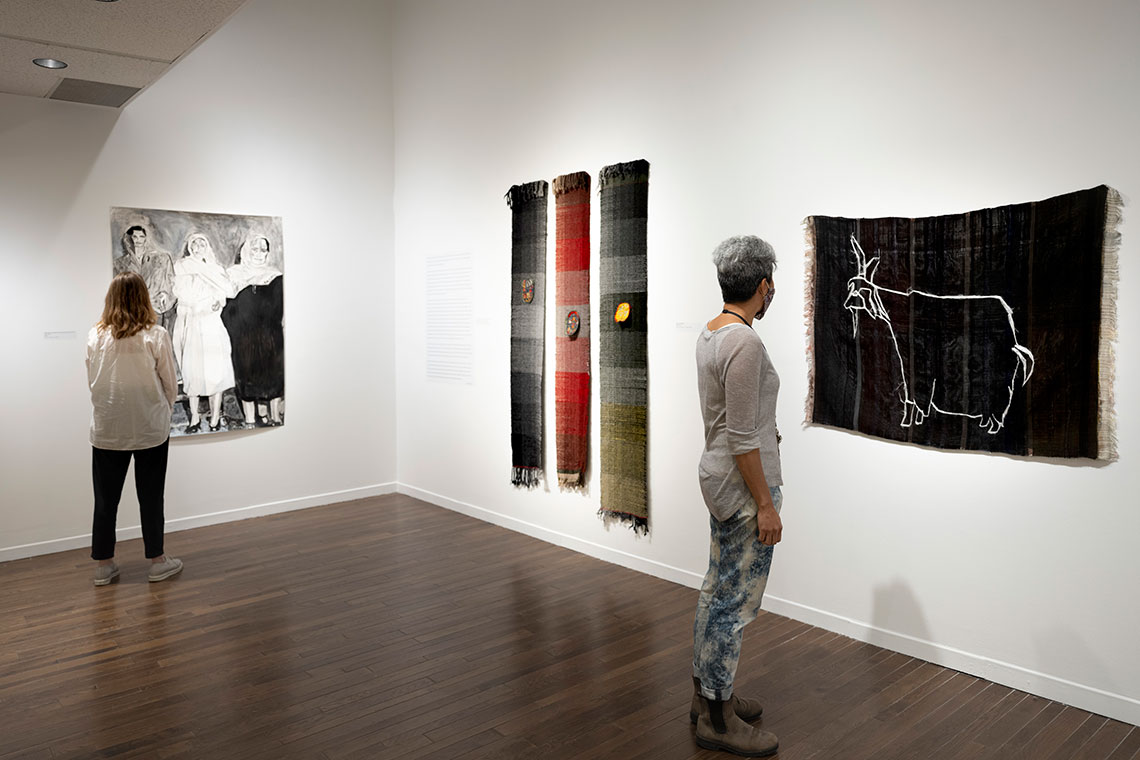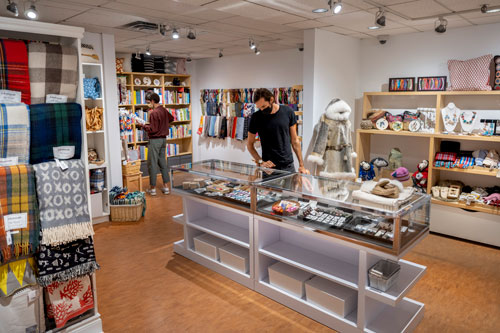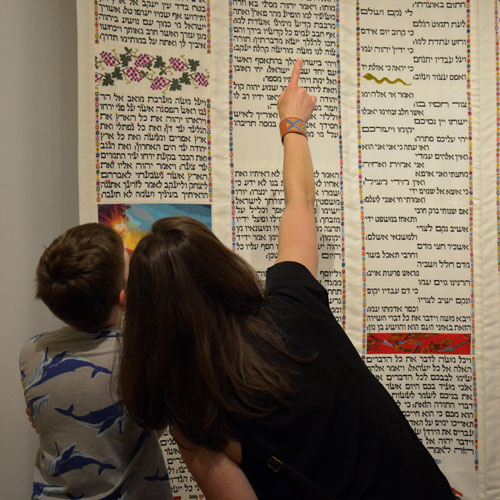Visitor Guidelines
Welcome!
Learn about our current exhibitions and programs on our What’s On page. The Textile Learning Hub is open to visitors for studio activities, in addition to the Library, the Life Cycle of a Textile display, and the reimagined Textile Reuse Program, featuring great deals on fabric and notions. The Museum Shop is also open for in-person or online shopping.
Everything you need to know about visiting the Textile Museum of Canada, including updated COVID-19 guidelines and safety measures, can be found in the FAQ below. The Museum is grateful for our community’s continued support through these unprecedented times.

01. Plan Your Visit
Opening hours:
Sunday & Monday: Closed
Tuesday: 12 pm – 5 pm
Wednesday: 12 pm – 6 pm
Thursday to Saturday: 12 pm – 5 pm
Advanced ticket reservations are available online.
02. Visitor Guidelines
Health and safety is our top priority – Please contact us at admissions@textilemuseum.ca if you have any questions.
Please follow these guidelines when inside the Museum:
- Contactless payment is preferred.
- Please do not touch the objects on display, you can explore tactile experiences in our Textile Learning Hub
- There is no storage for large bags or suitcases at this time. Backpacks must be worn on your front.
- No food or drink allowed. The water fountain is temporarily unavailable, and water bottles are allowed but must remain sealed at all times while in the galleries.
- Please self-screen before your visit. If you feel ill or are experiencing symptoms, please stay home.

03. FAQ — General
Opening hours:
Monday to Tuesday: Closed
Wednesday to Sunday: 11am – 6 pm
You can buy a ticket to visit the Museum here and tickets are also available for at the door. We welcome walk-ins anytime the Museum is open, walk-ins for programs will depend on availability.
We happily honour all reciprocal admission, gift passes and other free admission passes (such as Toronto Public Library’s MAP program).
Members can access the Museum by booking a ticket online here. Members can also present their membership card at reception to gain access
If you are having trouble booking your tickets, please contact admissions@textilemuseum.ca
Our Museum Shop is available for in-person shopping and online 24/7 at shop.textilemuseum.ca.
Access to our Museum Shop does not require paid admission to the Museum, please speak to our reception desk about access.
If you are interested in an item that you don’t see online, please email shop@textilemuseum.ca and we’d be happy to facilitate your order.
Photography and Video Recording
Photography (without flash) and video recording is allowed everywhere in the Museum, for personal use only. Please tag us on Instagram (@textilemuseumofcanada) and Facebook! For media requests, please contact Caitlin Donnelly, Digital Marketing Coordinator, at cdonnelly@textilemuseum.ca or 416-599-5321 x 12.
Food and Drink
No food or drink is allowed in the galleries. Parents are welcome to breastfeed anywhere in the Museum.
Drawing and Sketching
No pens or markers are allowed in the galleries. Pencils and pencil crayons may be used.
Scents
We ask for your cooperation in keeping the Museum scent-free in order to maintain a safe and enjoyable visit for everyone. Visitors are encouraged to avoid or reduce the use of heavily fragranced products, which may include perfumes/colognes and scented lotions.
Video Surveillance
For the protection of visitors, staff and our exhibitions, the Textile Museum of Canada is monitored by video surveillance.
Animals
Pets are not permitted in the Museum; however, service animals are allowed.
US Tender
We accept American cash at par.
We are offering a rich variety of programming such as workshops, artist talks, and tours. Please keep an eye on our What’s On page for our upcoming programs!
At this time, due to the Museum’s conservation policies, no outside materials can come into the Textile Learning Hub space, our galleries, or our Museum Shop. Visitors can explore drop-in activities and use provided materials or items purchased from our Textile Reuse Program. Please note that occasionally the Learning Hub will be unavailable to visitors due to programming or rentals – please call our reception desk for more information – 416-599-5321. Visitors are welcome to bring paper and pencil into our spaces and personal non-flash photography is permitted.
Learn more about our Group Tours, explore our selection of offerings, and book here. For any additional inquiries, please contact our Programs & Tours Assistant Maria Moreno – mmoreno@textilemuseum.ca
Learn more about our School Visits, explore our selection of programs, and book for your group here. For any additional inquiries, please contact our Programs & Tours Assistant Maria Moreno – mmoreno@textilemuseum.ca
We are happy to offer facility rentals of our Museum – please see our facility rental page for more information.
The Museum has one small elevator that provides access to all floors of the Museum.
Yes, we have one manual wheelchair available for visitor usage. Please reserve it ahead of time by emailing admissions@textilemuseum.ca or call 416-599-5321 during opening hours
Washrooms are available on the mezzanine and second floor.
Mezzanine: All-gender and single-use.
Second Floor: Two all-gender washrooms, each with an accessible stall for wheelchairs or mobility scooters.
Please ask a staff member if you have any questions about our washroom policy.
You come into contact with them every day!
Textiles are objects that protect the body, furnish the home, and express personal and cultural identity.
Made from a wide range of natural and synthetic materials, they demonstrate the ingenuity of their makers, who transform wool, cotton, silk, animal skins, bark, polyester, or grass into cloth that perfectly suits its purpose.
Our collection represents historic techniques that continue to be practiced today. It includes woven textile fragments from 11th century Egypt, an Inuit seal skin appliquéd hanging, a Malaysian cowrie shell war vest made around 1910, an early 20th century camel headdress from Afghanistan, Indigenous beadwork, a child’s suit made from salmon skin from China, hooked rugs and quilts from across Canada, a collection of Chinese children’s festival hats, William Morris curtain fragments, prayer rugs from Iran, indigo-dyed women’s wrappers from Nigeria, and woven alpaca ponchos from Bolivia.
Our contemporary exhibitions celebrate textiles as personal and cultural expressions, technical innovation, cultural continuity, and new materials.
The Textile Museum of Canada is relevant to anyone who has clothes on right now, or who stepped out from between the sheets this morning to open the curtains and put their feet on the rug. These are just a few of the basic encounters we have with textiles and fibre, but it’s a global human experience that runs deep and rich.
We have digitized our collection of over 15,000 objects, and they can be viewed online here. We incorporate objects from our collection into our exhibitions whenever possible. We are excited to have permanently opened a new collection gallery on our 2nd floor.
For private collections visits, please contact Senior Curator, Manager of Collection Roxane Shaughnessy for inquiries at rshaughnessy@textilemuseum.ca.
Textiles are one of the most light-sensitive materials that you will find on display at a museum. Exposure to light causes weakness of fibres and fading, which can result in severe damage to textiles if left unchecked. All forms of light can cause damage but light sources with high UV content, such as daylight, are the most destructive. Light damage to textiles is cumulative and irreversible, so it’s important for us to reduce the amount and intensity of light exposure to our collection whenever possible.
The Museum uses a dimming LED lighting system in our galleries, as it contains low levels of the UV spectrum and can be adjusted for the needs of individual pieces. We also have motion detectors that dim the lights when no one is in a gallery to reduce the amount of light exposure a textile receives. Placing a light source father away from an object reduces the intensity of light exposure that an object receives while on display. For this reason, we do not place spotlights within our cases.
We strive to make our galleries accessible for our visitors but sometimes the needs of the textiles on display require low lighting levels for their care. If you are finding that the lighting in a gallery is making it difficult to read the labels, a clear print exhibition guide is available at the front desk. Tours for visitors with low vision are also available through our education department.
Please do not. Our museum is special because there is no glass separating you from the artifacts on display, and you can get up close. But we ask you not to touch, and here’s why:
Our skin contains oils, salts, and residues. When people touch an object, these things build up and result in chemical reactions that cause deterioration. Damage caused to textiles is a slow, gradual process and the immediate effect of poor handling is not apparent. Although the damage isn’t as easy to see as a ceramic vase breaking when you drop it, it’s still happening!. This also means that a textile, especially an old one, is probably much more fragile than it looks at first glance. Dyes, chemicals, and a variety of natural but slightly gross substances are often used to make textiles. These can remain on the surface and touching them means they will get on your hands and clothing.
In short, we ask you not to touch because it keeps you and the textiles safe. The longer we keep an object in good condition, the more people will get to see it. Please help us preserve our collection for generations to come.
The Museum is grateful for the donation of objects to the collection. However, please note that we have currently placed a moratorium on new acquisitions as we undergo an in-depth review of our policies. For more information, contact collections@textilemuseum.ca
Our popular fabric fundraising and textile sales are now available year-round through our Textile Reuse Program, located on the second floor of the Museum!
Please visit Textile Donation – Textile Museum of Canada for more information about the Reuse Program. To donate, please send images of your items to reuse@textilemuseum.ca
We have put together a list of resources for textile enthusiasts and owners including local independent appraisers and conservators. Due to the overwhelming number of requests we receive, we are not able to respond to inquiries relating to artifacts which are not in our collection.
Yes! Check out our Get Involved page to learn more about volunteering at the Museum and find out if there are currently any job openings.
